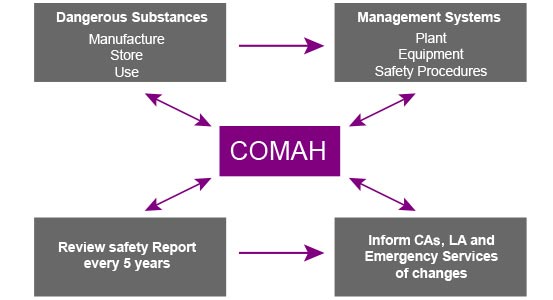Introduction
In this unit we look at another significant element in the field of Process Safety Management. You will remember that in unit 1 we looked at the Flixborough disaster, which occurred in 1974, and it was pointed out that this incident along with the Toxic release at Seveso in Italy led to the development of the UK CIMAH and then the COMAH regulations.
The UK COMAH regulations, on which this unit focuses, govern the operation of major accident hazard sites where process safety accidents are most likely to occur.
2.1
Control of Major Accident Hazards Regulations 2015 (COMAH)
Enforcement
What is COMAH?
Under COMAH, operators of sites with dangerous substances above a specified quantity must take all necessary measures to prevent major accidents, and in the event of such accidents, limit the effect on people and the environment.
Who comes under COMAH?
Operators of so-called upper-tier establishments (of which there are approximately 350 in the UK).
Who enforces COMAH?
COMAH Regulations are enforced by the Competent Authority (CA). In England and Wales the CA is the Health and Safety Executive (HSE) and the Environment Agency. In Scotland, it is the HSE and the Scottish Environment Protection Agency (SEPA).
The CA is responsible for checking that site operators take steps to prevent and limit the effects of major accidents.
HID - Hazardous Installations Directorate‘…HID's role is the effective regulation of major hazard industries whose products are essential to our everyday life, but where failures in safe management and risk control can lead to catastrophic harm to workers and the public at large. These industries involve complex processes with intrinsic hazards that need careful management.’
2.2
Control of Major Accident Hazards Regulations 2015 (COMAH)
Enforcement
UK COMAH Regulations
Under the COMAH, operators of sites with dangerous substances above specified quantities – so-called ‘upper-tier’ companies - have to take all necessary measures to:
Prevent major accidents; and in the event of such accidents, limit the effects on people and the environment.
The Health and Safety Executive’s definition of a major accident is‘…an occurrence (including in particular, a major emission, fire or explosion) resulting from uncontrolled developments in the course of the operation of any establishment and leading to serious danger to human health or the environment, immediate or delayed, inside or outside the establishment, and involving one or more dangerous substance.’
-
Safety management in major hazard industries explains how HID regulates major hazards and describes the system dutyholders are expected to have in place to manage them.
Click resources to access the HID Regulatory Model.
2.3
Control of Major Accident Hazards Regulations 2015 (COMAH)
Enforcement
The Big Picture
Within the Hazardous Installations Directorate document that discusses Major Hazard Management Systems for the High Hazard Industries, the video linked in this page gives an overview of how these systems can be incorporated.
2.4
Control of Major Accident Hazards Regulations 2015 (COMAH)
Emergency plans
The tabs below contain some important information, which you should read carefully, as it is closely linked to the learning process in this unit.
On-Site Emergency Plans
COMAH requires operators of Upper Tier establishments in the UK to prepare and keep up to date on-site emergency plans, and to supply necessary information to their Local Authority, who are required to prepare an off-site emergency plan. Both plans have to be produced in writing.
The on-site emergency plan is prepared by the operator, and specifies the response to the emergency of those who work on the site.
Off-Site Emergency Plans
The off-site emergency plan is prepared by the Local Authority (LA), and specifies the co-ordinated response of agencies to an emergency on the site which has off-site effects.
The objectives of on and off-site emergency plans
Contain and control incidents so as to minimise the effects, and to limit damage to persons, the environment and property.
Implement the measures necessary to protect persons and the environment from the effects of major accidents.
Communicate the necessary information to the public and to the emergency services and authorities concerned in the area.
Provide for the restoration and clean-up of the environment following a major accident.
Emergency Preparedness
Case Studies
The following videos look in general at the principle of Emergency Preparedness, citing a number of examples in which a lack of preparation, training and communication had a direct effect on the level of severity and consequences of disasters involving hazardous materials. The second and third videos each take a closer look at a single incident.
After watching each video, you may wish to refer back to earlier pages in this unit, or to other units, to consolidate the link between theory and practice.
 On-Site
On-Site 